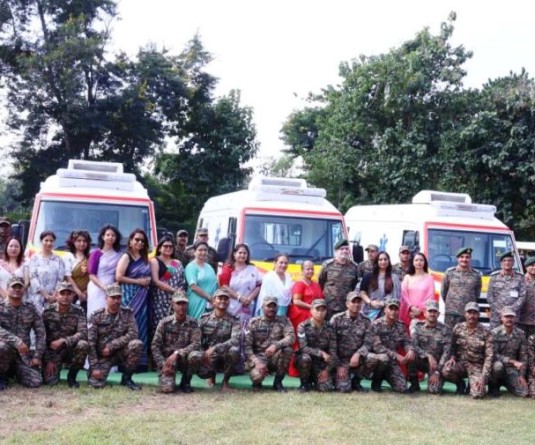
@ 25.5%, HIV prevalence rate in Noklak still one of highest in country
Morung Express News
Kohima | August 1
Noklak district, with a high presence of People with Injecting Drugs (PWID), have one of the highest HIV incidences in the country with a reported prevalence rate of 25.5% (source TI data). This was revealed during the first ever Nagaland Harm Reduction conference held at Kohima on August 1.
Currently, the TI Drop-In Centre, established by the Khiamniungan Baptist Church Association (KBCA) is reaching out to 341 IDUs out of which 87 IDUs are HIV positive. However, only 45 of them are on Antiretroviral (ARV) medications due to various programmatic and logistic challenges, which now remain a matter of great concern and needs urgent attention.
Dr. Ngangshimeren, project director NSACS pointed out that there are new areas of concern emerging each day and one cannot remain complacent harping on past achievements. Besides the targeted populations, there is need to focus on the prevention of HIV transmission among the general population at large, he remarked.
At the same time, he stressed on the need to fast tract early detection of HIV infection and linkage to treatment and care; the need to create an enabling environment and strengthen the sensitization effort among the target population including spouses of HRGs and children of HIV positive parents; and also the alarming rate of transition of transmission route from IDU to that of sexual route.
Abou Mere, President of NNagaDAO and director, Kripa Foundation said the frequent unavailability of critical lifesaving ARVs resulting in unnecessary and untimely switch of ARV regiments has become a major public health emergency with serious implication for the very survival of PLHIV, which leads to development of resistance and virological failure on ART.
He also called on the need for installing a viral load machine in Naga Hospital Authority Kohima, for the state of Nagaland, as a monitoring tool to provide quality management system (QMS), and improve access to routing viral load testing and achieve viral load suppression for both HIV and Viral Hepatitis besides allowing for timely detection of PLHIVs who are eligible for second-line or third-line ARV treatment or timely detection of viral hepatitis treatment failure.
Nagaland is the 3rd highest adult HIV prevalence in the country at 0.76 % and 91% of the cases in Nagaland is through the sexual route, as per NACO and NSACS official record, Mere, however, was perturbed as to which group of population is driving the epidemic in the state.
Though the HIV data suggest sex to be the highest route of transmission, there is no scientific study done to determine as to which group of population is driving the epidemic - the drug users, alcoholics, FSW, MSM, General youth population, students, unemployed youth, police, army or national workers etc? questioned Mere.
Towards this end, he emphasized on the need to do a comprehensive review and in-depth study to understand the main driver, and the need to develop intervention strategies to address the ‘driver’ of the epidemic in Nagaland.
History of drug addiction
The history of drug addiction in Nagaland may be traced back as early as the early 80's, recalled Dr. Ngangshimeren. The drug in its purest form was readily accessible in Nagaland making its entry from the Golden Triangle of the Southeast Asia. Gradually, drugs like marijuana, diazepam, codeine, SP and some cough syrup families were also abused whenever heroin was not available for various reasons.
Before long, due to high demand and compounded by non-availability of alcohol because of the state government's Total Liquor Prohibition Act 1989, heroin as well as the other drugs came with exorbitant price in the market leading to economic bankrupts in the families of the users' community.
As a result of drug addiction, Dr. Ngangshimeren said, schools and college dropouts increased resulting to total family and social disintegration among the drug users' community. This resulted in anti-social activities such as thieves, burglaries, robberies; murders etc which became daily affairs in the community all in search of resources for their daily dose.
Further, in the absence of a harm reduction programme in place, the total ban on the sale of needle and syringes in the year 1994 by the state government as a strategy to contain the IDU's had a significant negative impact in the HIV/AIDS program in the state. This in turn, he said, resulted in rampant sharing of needle and syringes among the IDU's giving rise to spread of HIV and Viral Hepatitis among the IDU community.
Adding more woes to the drug users, they were labeled criminals, were awarded punitive punishments in the form of physical torture, imprisonment, excommunication both by the civil authority, societies and non-State force alike, in the name of eradicating social evils, recalled Dr. Ngangshimeren.
On the other hand, drug overdose-related deaths and other drug related side effects resulted in untold miseries and sufferings among the user's community with no one to support them, he added.
Challenges of Women who Use Drugs (WUD)
Often described as ‘hard to reach’ population, Women who Use Drugs (WUD) are a highly vulnerable group with specific challenges and needs that are not addressed in the current drug and HIV prevention and treatment policies and programs, said Mere.
He rued that they continue to remain hidden and isolated, away from access to services, due to the strong stigma and discrimination faced by them, with very little attention given to address the multiple factors that act as barriers for access to health services.
“They are unable or reluctant to come to the forefront and take up leadership roles in advocating for their various issues affecting their lives due to high levels of stigma and social exclusion,” said Mere and stressed that this must be eradicated and women who use drugs should be empowered to access services and to take care of their health responsibility.
A call to government, stakeholders
Stating that substance use, HIV and Viral Hepatitis is not just an individual problem but a psychosocial, socio-economic, socio-political and a human rights issue, Mere said a holistic approach and appropriate strategies need to be developed and implemented so that prevention, treatment and social re-integration are ensured.
He also appreciated the Nagaland political leadership cutting across party line for passing the “Nagaland State Substance Abuse Prevention and Treatment Policy.”
The day-long conference held at The Deck, Hotel Vivor was organised by the Nagaland State AIDS Control Society and Agent for Change on the theme ‘Moving ahead, marching together’ in partnership with the state government, NACO, UNAIDS, fHI360, CDC, Kripa Foundation, India AHIV/AIDS Alliance etc.
The inaugural programme was graced by R. Ramakrishnan, principal secretary, H&FW as the special guest and Dr. Bhawani Singh, deputy director NACO as guest speaker.





